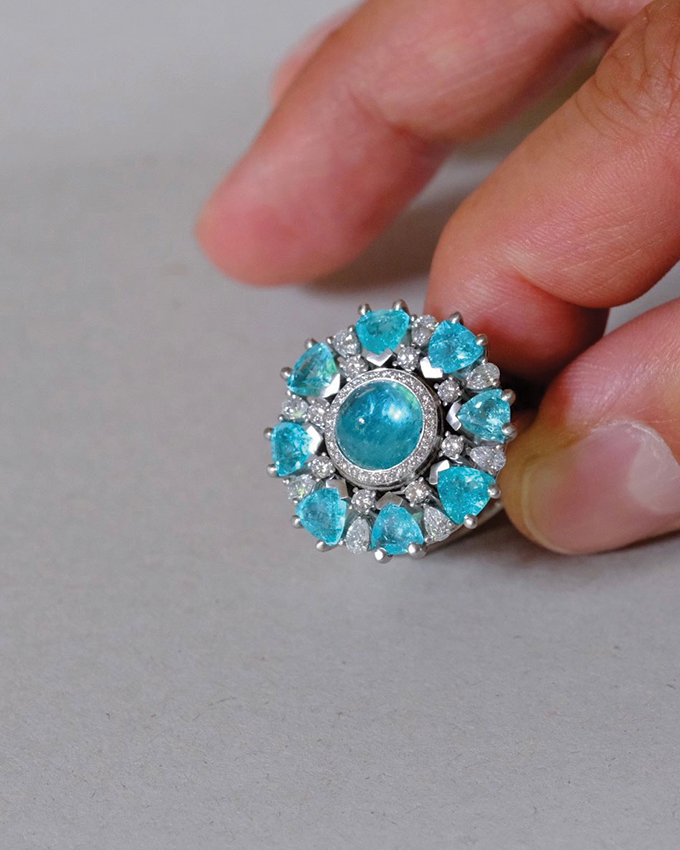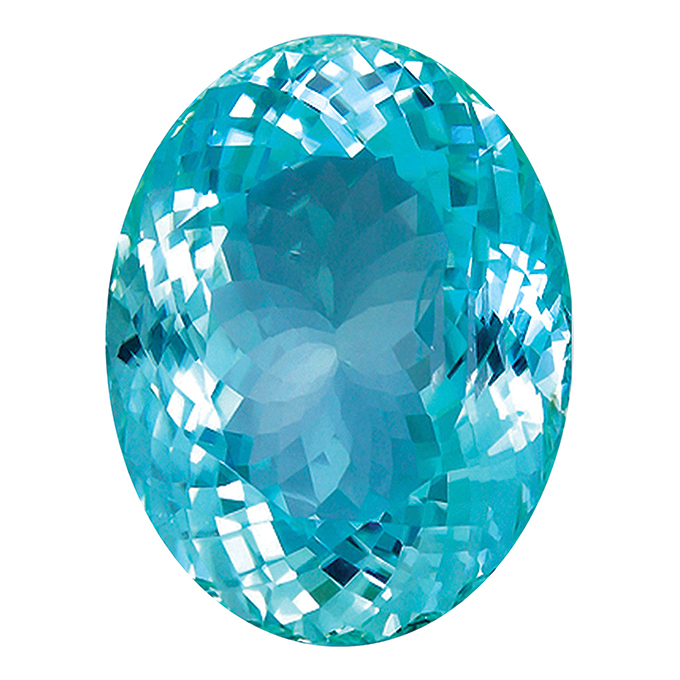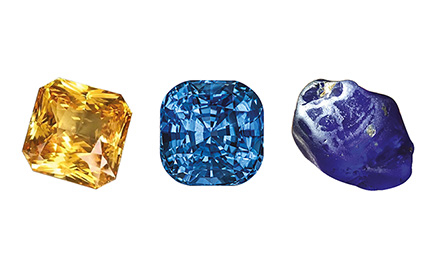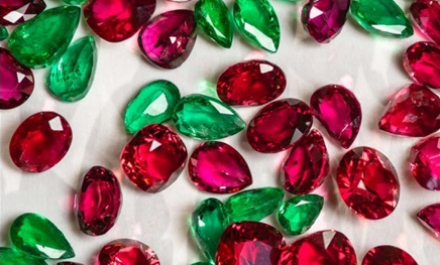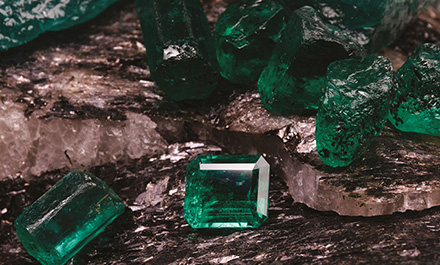The Paraiba tourmaline has captivated gem enthusiasts worldwide with its electrifying neon blue colour. Its popularity shows no signs of waning as demand continues to soar amid limited supply and price increases, according to gem dealers.
This article first appeared in the GEMSWORLD 2024.
In the world of coloured gemstones, few have garnered as much attention and admiration as the Paraiba tourmaline. This robust market demand can be attributed to the beloved gem’s striking neon blue or bluish-green colour, which is incomparable to other stones.
Paraiba tourmalines have also been appearing front and centre in mainstream high-end jewellery collections, which industry players say is instrumental to the gem’s rising popularity among a wider range of consumers.
According to gem and jewellery dealers, strong demand and limited supply from the mines are pushing Paraiba tourmaline prices up, but consumers remain willing to pay a premium for the best-quality gems.
These copper-bearing tourmaline variants were first unearthed in the late 1980s in the Brazilian state of Paraiba, from which its name is derived. Nigeria and Mozambique in Africa are other major sources of Paraiba tourmaline.
Market overview
Demand for Paraiba tourmalines continued its upward trajectory amid challenging times, with the US, Europe and Asia driving growth.
Niveet Nagpal, president and designer of Los Angeles-based jeweller Omi Privé, described Paraiba tourmalines as among the few stones that sell even when they are slightly included or come in a cabochon cut.
“The stone’s exceptional saturation and distinctive neon blue to green hues set it apart from other gems. These are the most important factors considered by clients when making their purchases,” explained Nagpal. “We expect higher demand for smaller stones as these are more affordable. There is also growing interest in finer-quality Paraiba tourmalines.”
According to Angela Yuen, managing director of Wilds Co Ltd in Hong Kong, upper- and middle-range qualities of the gem are enjoying solid demand. “Some buyers look for more accessible Paraiba tourmaline pieces for daily wear while others desire heirloom or investment pieces. Still, most buyers prioritise the quality of the gem,” she said.
Amit Dugar, director of RMC Gems HK, agreed, adding that consumers want medium- to high-quality gems, specifically those of 2 carats and above. The most sought-after shapes are oval and pear.
Meanwhile, prices have surged over the past three years. He said, “Prices of Paraiba tourmaline from Mozambique have gone up by at least 100 per cent to 200 per cent, and there is still room for further increases. Meanwhile, prices of Brazilian Paraiba tourmaline have increased by 50 per cent. There is hardly any production from Brazil; prices continue to remain high.”
Dugar explained that the Mozambique variant is inherently more affordable as it sells for around 20 per cent to 30 per cent of current Brazilian Paraiba tourmaline prices. However, prices of Mozambique gems are expected to rise in the future depending on the quality, colour and size of the stone.
Exceptional designs
The gem’s intense colour saturation and stunning clarity make it highly desirable among jewellery designers seeking a truly extraordinary material.
Sebastian Leyser, co-founder and head of business development of Switzerland-based Leyser Ltd, described the natural fluorescence of Paraiba tourmalines as a “magical glow” that captivates audiences. To accentuate the gem’s inherent beauty, the company combines Paraiba tourmalines and diamonds in platinum in its jewellery collections.
Paraiba tourmalines’ unique colour also complements other stones perfectly, Yuen of Wilds Co Ltd commented, adding that pairing small Paraiba tourmalines with other stones creates an unexpected and stunning effect, further enhancing the beauty of the adjacent gems.
Yuen shared, “We had a client who requested a custom-made jade jewellery. With our expertise, we proposed incorporating Paraiba tourmaline to further add elegance to the piece. The outcome was a remarkably harmonious composition where the Paraiba tourmaline imparted an exquisite radiance to the jewellery, elevating its overall aesthetic with a modern touch.”
Bright outlook
Paraiba tourmalines come in a range of spectacular colours – from electric blue to bluish green or greenish blue. Dugar of RMC Gems HK said each colour has its own following, depending on buyers’ personal preferences. European consumers opt for greenish-blue stones while the Chinese market is partial to blue, he disclosed.
“The best part is that every colour of Paraiba tourmaline has its dedicated market where it sells exceptionally well,” he remarked.
Nagpal of Omi Privé is likewise optimistic about business opportunities, adding that the coloured gemstone, whether loose or mounted, moves fast, particularly Paraiba tourmalines from Brazil.
“We expect further growth but this will be limited by supply constraints,” added Nagpal. “It will be a slow but steady growth. Neon blue Paraiba tourmalines displaying higher saturation and clarity are always in high demand and are likely to exhibit a faster pace of growth.”
While its rarity and unique appeal make it a symbol of luxury and exclusivity, Paraiba tourmaline is also seen as a viable investment piece, said Sebastian of Leyser Ltd.
“Because of high price points, I do not see Paraiba tourmalines being sold in large quantities. However, you can expect to see brands using these in their luxury jewellery collections,” Sebastian added.
According to Zack Wang, founder of China-based jeweller Farrugia, there is still a significant portion of consumers who are unfamiliar with Paraiba tourmalines, and this represents an untapped market potential. Farrugia offers a fine selection of Paraiba tourmaline jewellery pieces.
He remarked, “With growing consumer awareness, Paraiba tourmaline is poised to become the next highly coveted coloured stone among enthusiasts, following rubies, emeralds and sapphires. Gem lovers will soon consider this colour a must-have in their collections.”
Amid a rosy outlook, gem dealers said rising demand and low production could result in even higher prices as well as difficulties in fulfilling orders. For her part, Yuen of Wilds Co Ltd said the market will need at least a year or two to absorb current price levels and anticipated increases.




